
Material - Enameling
Vitreous enameling is the process of fusing powdered glass to a metal substrate at high heat. The enamel melts, flows, and fuses to the surface in a smooth coating when heated to a temperature
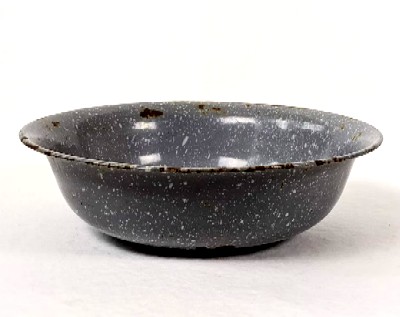
Enameled German Cookware, Late 19th c., Etsy
between 1400 and 1,650 degrees F (650 to 900 deg C.) "From a practical standpoint, enameling is a quality method of strengthening materials and preventing metals from rusting. ...Cast iron enameled bathtubs and sinks are also enameled to prevent rust and can last hundreds of years." (Kristin Arzt, "The Art Of Enameling: Learn Different Types & Techniques for Enameling", The Crucible website, gathered 5/5/25)
Enameling dates back to ancient Egypt with the insertion of crushed stones into jewelry and ornaments, although this was not vitreous enameling because it wasn't fired onto metal. The earliest known extant example of true enameling on metal comes from six gold rings found in a 13th century Mycenæan tomb. "In history, enamels were initially applied on firstly gold, then silver, copper, bronze and more latterly on iron and steel." ("A concise history of enamel", Institute of Materials, Minerals and Mining website, gathered 5-9-25)
Before the 18th century, enameling was reserved for art, jewelry and religious artifacts. Enameling entered the realm of practical household items in Germany in the 1760s when cast iron cookware began to be produced in an effort to prevent food cooked from acquiring a metallic taste from pots and pans as well as to prevent rusting. In the 1880s, inventor David Buick created a process to bond porcelain enamel to cast iron. This eventually led to the creation of the porcelain enameled bathtub industry, although it appears to have been adopted gradually. "Far from the ornate feet and luxury most associated with clawfoot tubs, an early Kohler [company] example was advertised as a 'horse trough/hog scalder, when furnished with four legs will serve as a bathtub.' The item's use as a hog scalder was considered a more important marketing point than its ability to function as a bathtub." ("Bathtub", Wikipedia, gathered 5-9-25)
In the early 1900s, another cast iron fixture began to be porcelain eanameled: stoves. By the 1910s, gas stoves often included an enameled coating, making them easier to clean. "By the early 1920s, gas stoves with enameled porcelain finishes for easier cleaning had become widely available, along with heavy use of insulation for fuel-efficiency." ("Gas stove", Wikipedia, gathered 5-12-25)
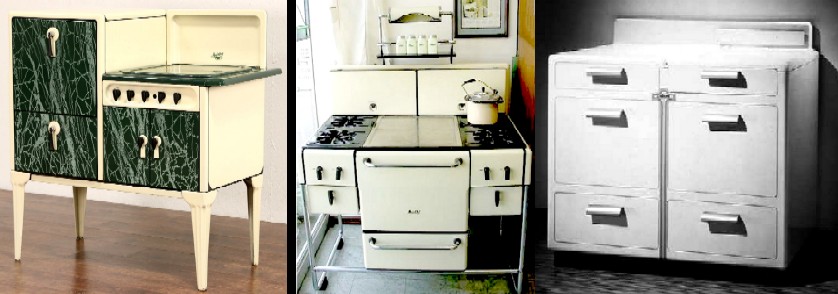 Enameled Art Deco Era Stoves, From left - Magic Chef Gas Range by American Stoves, Cream and Marbleized Green Enamel, Bakelite Knobs 1920s, Harp Gallery.; Magic Chef 1400 Gas Range, Cream and Black Enamel with Chromed Steel Bars and Matching Condiment Containers, 1937, Buckeye Appliance; Acorn Gas Range by Standard Gas Equipment, White Enamel with Metal Pulls, Norman Bel Geddes, 1932, Norman Bel Geddes., From The Rise and Fall of Subjective Vision, Design and Culture, March 2015, p. 40
Enameled Art Deco Era Stoves, From left - Magic Chef Gas Range by American Stoves, Cream and Marbleized Green Enamel, Bakelite Knobs 1920s, Harp Gallery.; Magic Chef 1400 Gas Range, Cream and Black Enamel with Chromed Steel Bars and Matching Condiment Containers, 1937, Buckeye Appliance; Acorn Gas Range by Standard Gas Equipment, White Enamel with Metal Pulls, Norman Bel Geddes, 1932, Norman Bel Geddes., From The Rise and Fall of Subjective Vision, Design and Culture, March 2015, p. 40
A related appliance from the Art Deco era which which was frequently enameled was the room stove. These were typically low to the ground, crouched in the corners of the room and often behind the furniture. Yet, during the 1920s and 1930s most room stoves were fueled with wood or coal and had to be somewhat accessible. As a result, these stoves were sometimes designed with appropriate features to match their surroundings, being coated with colorful or patterned enamels.
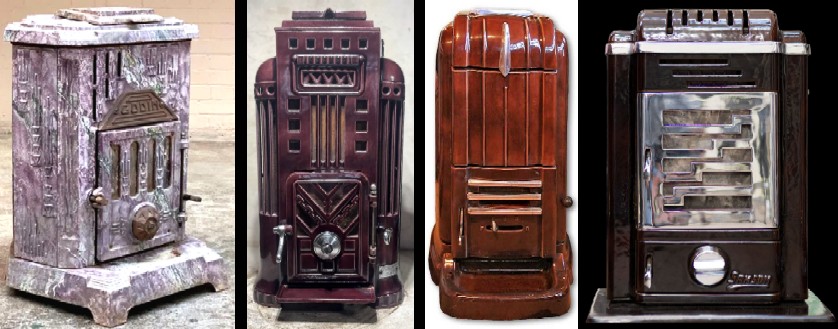 Enameled Art Deco Era Stoves, From left - Magic Chef Gas Range by American Stoves, Cream and Marbleized Green Enamel, Bakelite Knobs 1920s, Harp Gallery.; Magic Chef 1400 Gas Range, Cream and Black Enamel with Chromed Steel Bars and Matching Condiment Containers, 1937, Buckeye Appliance; Acorn Gas Range by Standard Gas Equipment, White Enamel with Metal Pulls, Norman Bel Geddes, 1932, Norman Bel Geddes., From The Rise and Fall of Subjective Vision, Design and Culture, March 2015, p. 40
Enameled Art Deco Era Stoves, From left - Magic Chef Gas Range by American Stoves, Cream and Marbleized Green Enamel, Bakelite Knobs 1920s, Harp Gallery.; Magic Chef 1400 Gas Range, Cream and Black Enamel with Chromed Steel Bars and Matching Condiment Containers, 1937, Buckeye Appliance; Acorn Gas Range by Standard Gas Equipment, White Enamel with Metal Pulls, Norman Bel Geddes, 1932, Norman Bel Geddes., From The Rise and Fall of Subjective Vision, Design and Culture, March 2015, p. 40
Somewhat in parallel with enameling, the first recognized piece
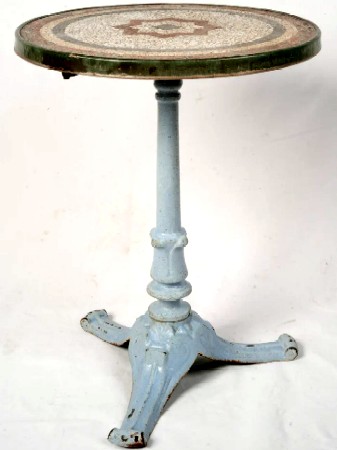
Guéridon Outdoor Table, Enameled Cast Iron with Terrazzo
Top, 1920s - 30s, Chez Pluie
of metal furniture - a cast iron table by Karl Friedrich Schinkel with lion paw feet - was built in 1820. Through most of the 19th century, cast iron furniture gained favor among furniture buyers, particularly for use in outdoor settings such as gardens. Here, enameling served a different purpose than appliance enameling: protection against moisture damage... as well as serving decorative needs.
The Art Deco 1920s transitioned from a luxury-focused market to the Streamline Moderne 1930s average consumer-focused market creating more mass-produced industrial designs. Some industrial designers (one in particular) saw an opportunity for mass produced enameled steel furniture. "Cast iron's ascendancy persisted until the advent of the Art Nouveau period [late 19th c.], marked by a disdain for mass production. The early 20th century, however, witnessed a revival led by [Bauhaus] designers like Marcel Breuer, Mart Stam, and Ludwig Mies van der Rohe, who embraced metal in various forms." ("Exploring the Legacy of Metal Furniture", Viet Cast Company website, gathered 5-9-25)
Among the manufacturers of metal furniture in the 1920s was the American firm Simmons Company, who began producing metal bedroom ensembles in 1923 which were marketed to the upper middle class. It must be remembered that the new Moderne furniture at this time was being produced for the wealthy, not for mass production. As such the Simmons lines were not Art Deco style, but were "more popular steel reproductions of Windsor, Chippendale, and Sheraton styles. These beds were enameled in color finishes or in wood-imitating enamel in Mahogany, Chestnut, American Walnut, or Maple. Both finishes camouflaged or subdued the look and feel of steel, removing the sleek, industrial finish promoted by streamlined design." (Dalila Huerta, "The Lure of Enameled Steel in the Interwar Period", Decorative Arts Trust website, gathered 5-9-25)
Simmons commissioned budding Industrial Designer Norman Bel Geddes to create enameled metal bedroom furniture in 1928 which embraced the Moderne design style. His designs began being sold in 1932, appearing at the Simmons Company display at the 1933 Chicago World's Fair which touched off the widespread adoption of the
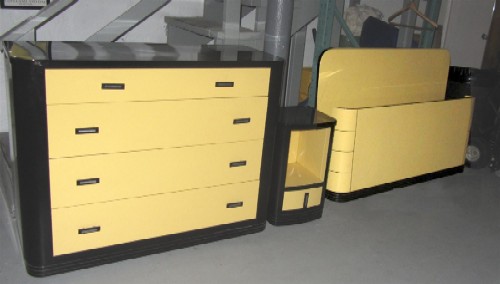
Bedroom Set, Dresser, Nightstand, Head and Foot Board, Yellow and Black Enamel on Steel,
Exhibited at the Chicago World's Fair, Norman Bel Geddes, 1933, Modernism
Streamline Moderne style in America. Interestingly, Dalila Huerta's research of the Simmons Company records indicates that the Bel Geddes' streamlined designs were not popular sellers for the company. It was a line of 'chromopathic' enamel finishes which took that honor.
Popular Simmons beds were sold under a veil of healthful promise, advertised for their chromopathic qualities that stressed the psychosomatic necessity of a 'restful bedroom' based on color. 'The nervous system responds to color very much as it does to music,' claimed Simmons' Color Therapy manual. "The mind craves something more positive than barren white, with its suggestion of winter coldness. It needs objects of interest, and above all the warmth and repose that color alone can furnish.' (Huerta)
Yet Simmons continued to manufacture metal furniture in the same style as Bel Geddes' designs even after his commission ended. As a result, "many pieces of '30s-era metal Simmons bedroom furniture are misidentified as Bel Geddes." (Ann Henderson, "Film & Interior Design: Seedy hotel room holds art deco gems", James River Film Journal, gathered 5-9-25) Huerta notes that Bel Geddes designs were not well advertised by the Simmons company until the post-war era when they launched a 'Modernization Bureau'.
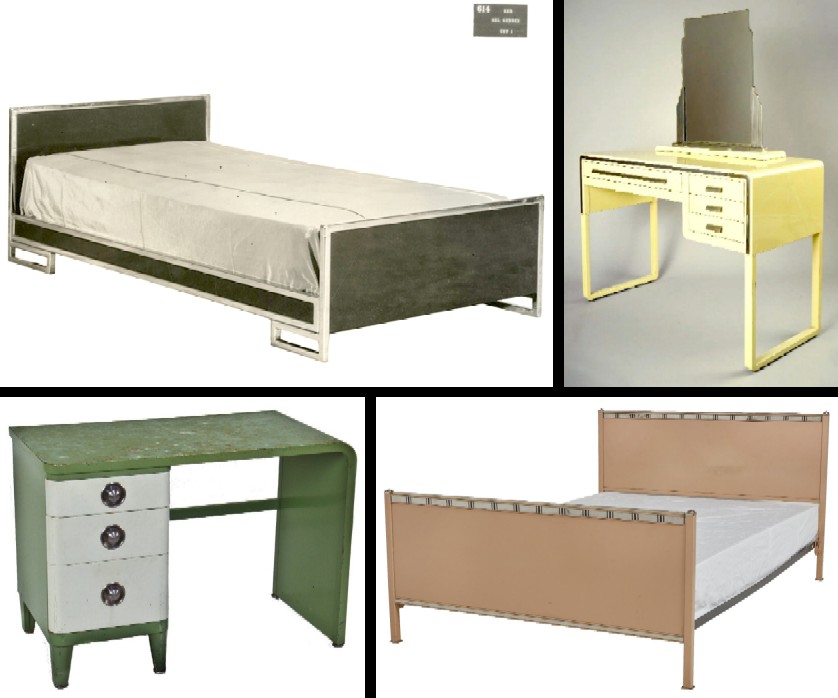 Enameled Streamline Moderne Furniture by Normal Bel Geddes for Simmons Company, From left - Twin Day Bed, Chrome and Enameled Steel, undated, University of Texas; Vanity with Mirror, Enameled Steel, Chromed Metal, Brass and Wood, 1930s, Brooklyn Museum; Streamlined Dupont Desk, Green and Off White Baked Enamel, 1930s, Urban Remains; Full Size Bed, Beige with Black Paint and Chrome, 1930s. Sotheby's
Enameled Streamline Moderne Furniture by Normal Bel Geddes for Simmons Company, From left - Twin Day Bed, Chrome and Enameled Steel, undated, University of Texas; Vanity with Mirror, Enameled Steel, Chromed Metal, Brass and Wood, 1930s, Brooklyn Museum; Streamlined Dupont Desk, Green and Off White Baked Enamel, 1930s, Urban Remains; Full Size Bed, Beige with Black Paint and Chrome, 1930s. Sotheby's
Many of the small statues manufactured during the Streamline Moderne 1930s were made of spelter, a zinc-based alloy, as a cheaper alternative to bronze. Enameling was sometimes used to give these statues a more polished appearance as well as to add color to the statues.
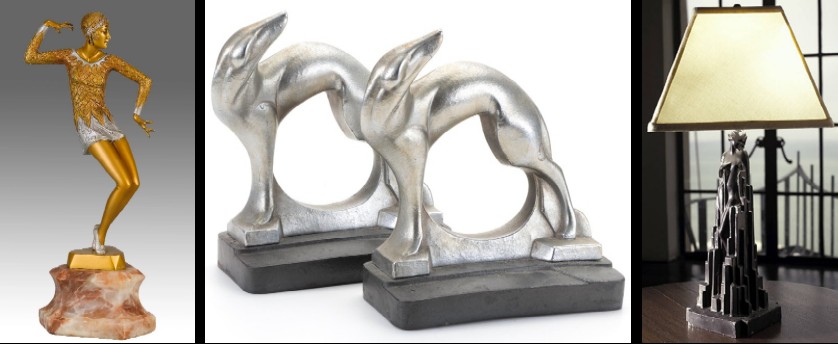 Enameled Statues, From left - Charleston Dancer Sculpture, Gilt and Enamel Bronze, Ferdinand Preiss, c. 1925, Hickmet Fine Arts; Greyhound
Enameled Statues, From left - Charleston Dancer Sculpture, Gilt and Enamel Bronze, Ferdinand Preiss, c. 1925, Hickmet Fine Arts; GreyhoundBookends, Silver Enamel Over Spelter, Frankart, 1920s, Everything but the House; Spirit of Modernism Lamp, Enamel Over Spelter and Shade, Frankart, 1928, Wright Auctions
Given all this it is curious that Industrial Designer Henry Dreyfuss felt the need to write, "...for a time in this chaotic period [of the 1930s] a person who knew how to enamel something black and put three chromium strips around the bottom was considered an industrial designer." (Henry Drefuss, Designing for People, 1955, p. 19) It seems likely that he was confusing lacquering, a popular process used particularly in French Art Deco designs during this period, and enameling.
Sources Not Mentioned Above:
"History of Enameling Techniques", MS Rau website, gathered 5-9-25
"500 years of enamel", Falcon Enamelware website, gathered 5-9-25
"Industrial porcelain enamel", Wikipedia, gathered 5-9-25 - [](https://en.wikipedia.org/wiki/Industrial_porcelain_enamel)
"Stoves evolved from black iron to enameled finishes", The Columbus Dispatch, Gathered from the Web 5-12-25
Original Facebook Posting